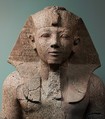Large Kneeling Statue of Hatshepsut
New Kingdom
This over life-size kneeling statue and two others in the collection (30.3.1 and 29.3.1) were made to flank the processional pathway along the axis of Hatshepsut's temple at Deir el-Bahri. They depict Hatshepsut as the ideal Egyptian king - a young man in the prime of life. Each statue has an inscription that includes her personal name, Hatshepsut (literally foremost of noblewomen) and/or a feminine pronoun or verb form, so the masculine garb and physique were not intended to trick people into thinking that she was a man.
Although traditionally the Egyptian throne passed from father to son, when the necessity arose, a female ruler was accepted. However, the trappings and symbolism associated with kingship were overwhelmingly masculine and the sculptors of this statue were following a tradition that extended back more than fifteen hundred years. In this tradition, the public image of the king, whether he was an infant, a frail old man or, in this case, a woman, was shown in the most powerful and imposing form – a young, vigorous man, or a human-headed lion-bodied sphinx (31.3.166). In this statue, Hatshepsut wears the nemes-headcloth, false beard, and shendyt-kilt that are part of the standard regalia of the king. On her chest she also wears the same enigmatic amulet suspended on a necklace of tubular beads that is represented on one of the statues representing Hatshepsut as a woman (30.3.3).
Due to rights restrictions, this image cannot be enlarged, viewed at full screen, or downloaded.
This artwork is meant to be viewed from right to left. Scroll left to view more.




